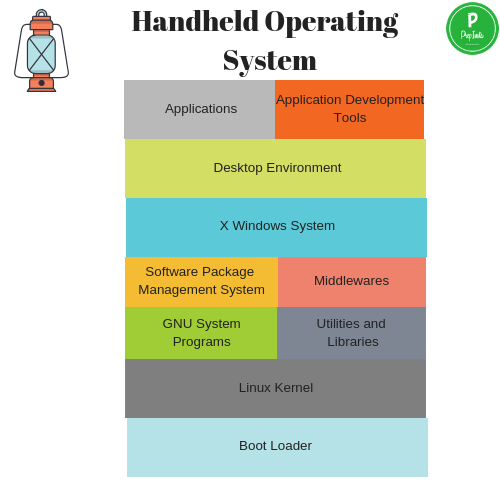Handheld System
Overview
Operating Systems that have low speed processors, less memory requirements and are ideal to be used in mobile devices and personal digital assistants (PDAs) are called Handheld operating systems. Such systems need fewer resources. These systems are also intended to work with different types of hardware. They are also known as Mobile operating systems.
Handheld devices are generally small in size that perfectly fits in the palm. These devices can be carried easily in pocket. These systems use Bluetooth, e-mail, Wi-Fi, GPS mobile navigation, video camera, music player, web browsing, and other wireless technologies. The most basic handheld devices are designed for personal information management (PIM) applications, allowing users to keep calendars, task lists and addresses handy.
Handheld devices liberate a large amount of heat generated by CPU. To deal with this, companies are designing smaller CPU with lower power requirements and lower heat generation. Many handheld devices use flash memory cards for their internal memory as large hard drives could not fit into handheld devices. There are three different connectivity options for handheld systems: first, synchronizing with a desktop or portable computer, second, connecting to a local area network (LAN), and third, connecting directly to the Internet.

Learn more about types of operating system here.
Types of Handheld System
The handheld system comes under a variety of sizes and shapes for different kinds of use. Handheld devices are generally categorized in two ways
Appearance/form factor
There are two divisions in physical appearance of handheld devices: tablet and clamshell designs. Tablets are small and have integral keyboards. Clamshell devices are miniature versions of keyboards and screens. Other form factors include different input mechanisms, handwriting recognition, processors, memory, wireless connectivity, wireless connectivity, battery types, displays, and cameras.
Operating system and functionality
Handheld operating system performs operations similar to that of the OSs of large desktops and their portable counterparts. The two most widely used OSs for handheld systems are Microsoft’s Windows Mobile suite and Palm OS.
Advantages and Disadvantages
Advantages of Handheld operating systems
- They are small and lightweight and easily portable.
- They take seconds to boot up.
- They have very long battery life.
- They are significantly lower in cost as compared to desktops or portables.
Disadvantages of Handheld operating systems
- Small screen-size limits usability.
- Prospective of expansion and upgrade is limited.
- They have low-speed processors and less memory.
- Interoperability and connectivity are limited at present.



Login/Signup to comment